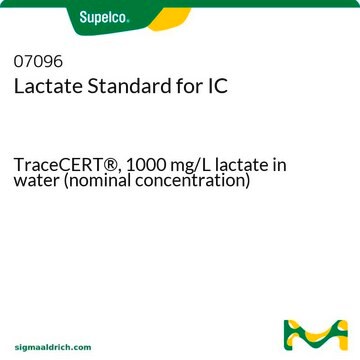1356734
USP
Ácido L-(+)-Láctico
United States Pharmacopeia (USP) Reference Standard
Sinónimos:
Ácido (S-2-hidroxipropiónico, Ácido sarcoláctico
About This Item
Productos recomendados
grado
pharmaceutical primary standard
familia API
lactic acid
Ensayo
89.1% (lactic acid basis)
fabricante / nombre comercial
USP
técnicas
HPLC: suitable
aplicaciones
pharmaceutical (small molecule)
Formato
neat
temp. de almacenamiento
2-8°C
cadena SMILES
C[C@H](O)C(O)=O
InChI
1S/C3H6O3/c1-2(4)3(5)6/h2,4H,1H3,(H,5,6)/t2-/m0/s1
Clave InChI
JVTAAEKCZFNVCJ-REOHCLBHSA-N
¿Está buscando productos similares? Visita Guía de comparación de productos
Categorías relacionadas
Descripción general
Aplicación
Also, for use with USP monographs such as:
- Fumaric Acid
- Maleic Acid
Nota de análisis
Otras notas
Producto relacionado
Palabra de señalización
Danger
Frases de peligro
Consejos de prudencia
Clasificaciones de peligro
Eye Dam. 1 - Skin Corr. 1C
Riesgos supl.
Código de clase de almacenamiento
8A - Combustible corrosive hazardous materials
Clase de riesgo para el agua (WGK)
WGK 1
Punto de inflamabilidad (°F)
235.4 °F - closed cup
Punto de inflamabilidad (°C)
113 °C - closed cup
Elija entre una de las versiones más recientes:
Certificados de análisis (COA)
It looks like we've run into a problem, but you can still download Certificates of Analysis from our Documentos section.
Si necesita más asistencia, póngase en contacto con Atención al cliente
¿Ya tiene este producto?
Encuentre la documentación para los productos que ha comprado recientemente en la Biblioteca de documentos.
Los clientes también vieron
Protocolos
Separation of DL-Lactic acid, ~90% (T)
Science Slam panel: Leading gene therapy developers discuss commercialization challenges and the importance of robust process development plans.
Science Slam panel: Leading gene therapy developers discuss commercialization challenges and the importance of robust process development plans.
Science Slam panel: Leading gene therapy developers discuss commercialization challenges and the importance of robust process development plans.
Nuestro equipo de científicos tiene experiencia en todas las áreas de investigación: Ciencias de la vida, Ciencia de los materiales, Síntesis química, Cromatografía, Analítica y muchas otras.
Póngase en contacto con el Servicio técnico





